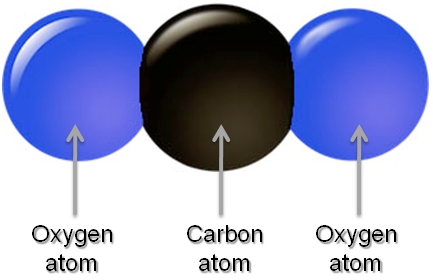How many electrons in ONE MOLE of carbon dioxide?
3 Answers
first calculate moles of
Explanation:
first calculate the moles of
= 2.27 mol
now number of electrons in
= 22
thus one mole of
Explanation:
The first thing to do here is to calculate the number of moles of carbon dioxide present in your sample. To do that, use the compound's molar mass
#100 color(red)(cancel(color(black)("g"))) * "1 mole CO"_2/(44.0color(red)(cancel(color(black)("g")))) = "2.27 moles CO"_2#
Next, use Avogadro's constant to figure out the number of molecules of carbon dioxide present in the sample.
#2.27 color(red)(cancel(color(black)("moles CO"_2))) * (6.022 * 10^(23)color(white)(.)"molecules CO"_2)/(1color(red)(cancel(color(black)("mole CO"_2))))#
# =1.37 * 10^(24)# #"molecules CO"_2#
Now, every molecule of carbon dioxide contains
- one atom of carbon,
#1 xx "C"# - two atoms of oxygen,
#2 xx "O"#

This means that your sample contains
#1.37 * 10^(24)color(red)(cancel(color(black)("molecules CO"_2))) * "1 atom C"/(1color(red)(cancel(color(black)("molecule CO"_2))))#
# = 1.38 * 10^(24)# #"atoms of C"#
and
#1.37 * 10^(24) color(red)(cancel(color(black)("molecules CO"_2))) * "2 atoms O"/(1 color(red)(cancel(color(black)("molecule CO"_2))))#
# = 2.74 * 10^(24)# #"atoms of O"#
Next, grab a periodic Table and look for the atomic numbers of the two elements. You will find
#"For C: " Z = 6#
#"For O: " Z = 8#
As you know, a neutral atom has equal numbers of protons located inside its nucleus and electrons surrounding the nucleus.
Therefore, you can say that every atom of carbon will contain
This means that you will have
#"total no. of e"^(-) = overbrace(6 * 1.37 * 10^(24))^(color(blue)("coming from C atoms")) + overbrace(8 * 2.74 * 10^(24))^(color(purple)("coming from O atoms"))#
#"total no. of e"^(-) = (8.22 + 21.92) * 10^(24)#
which gets you
#color(darkgreen)(ul(color(black)("total no. of e"^(-) = 3 * 10^(25))))#
The answer must be rounded to one significant figure, the number of sig figs you have for the mass of carbon dioxide.
Approx.
Explanation:
First, we calculate the number of electrons in ONE MOLECULE of
And then we calculate the number of carbon dioxide molecules in a mass of
And (finally) we solve the product:



